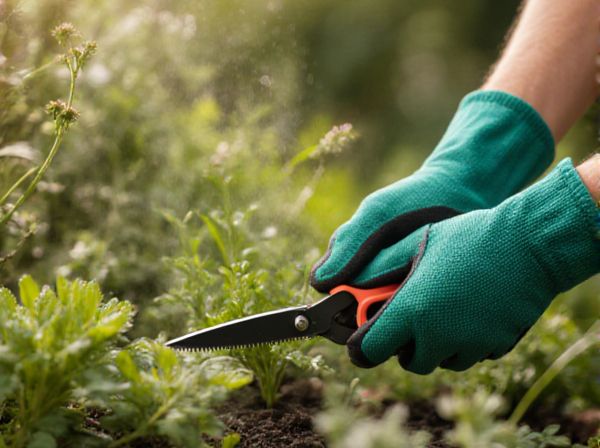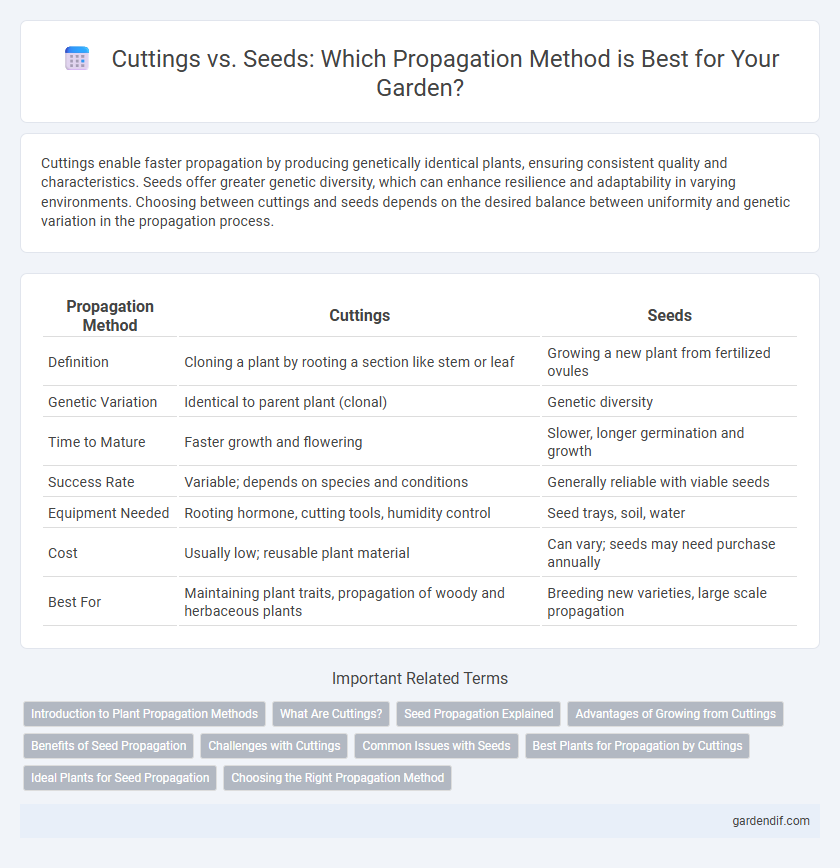
Cuttings vs Seeds Illustration
Cuttings enable faster propagation by producing genetically identical plants, ensuring consistent quality and characteristics. Seeds offer greater genetic diversity, which can enhance resilience and adaptability in varying environments. Choosing between cuttings and seeds depends on the desired balance between uniformity and genetic variation in the propagation process.
Table of Comparison
| Propagation Method | Cuttings | Seeds |
|---|---|---|
| Definition | Cloning a plant by rooting a section like stem or leaf | Growing a new plant from fertilized ovules |
| Genetic Variation | Identical to parent plant (clonal) | Genetic diversity |
| Time to Mature | Faster growth and flowering | Slower, longer germination and growth |
| Success Rate | Variable; depends on species and conditions | Generally reliable with viable seeds |
| Equipment Needed | Rooting hormone, cutting tools, humidity control | Seed trays, soil, water |
| Cost | Usually low; reusable plant material | Can vary; seeds may need purchase annually |
| Best For | Maintaining plant traits, propagation of woody and herbaceous plants | Breeding new varieties, large scale propagation |
Introduction to Plant Propagation Methods
Propagation methods vary in efficiency and genetic consistency, with cuttings offering a faster and more reliable way to replicate parent plants due to clonal reproduction. Seeds provide genetic diversity and resilience, crucial for breeding and adaptation, but require longer growth periods and variable germination rates. Understanding the advantages of cuttings and seeds helps optimize propagation strategies for horticulture and agriculture.
What Are Cuttings?
Cuttings are a method of plant propagation involving the removal of a stem, leaf, or root segment from a parent plant to develop roots and grow into a new plant. This technique allows for the cloning of the original plant, preserving its genetic traits and characteristics. Cuttings are commonly used for plants that do not produce viable seeds or to expedite the growth process compared to seed propagation.
Seed Propagation Explained
Seed propagation involves growing plants from seeds, ensuring genetic diversity and adaptability to various environments. This method allows for the development of strong root systems and typically results in healthier, more vigorous plants compared to cuttings. Seed propagation is ideal for crops that produce viable seeds and for breeders aiming to create new plant varieties with desirable traits.
Advantages of Growing from Cuttings
Growing plants from cuttings offers the advantage of producing genetically identical offspring, ensuring consistent plant quality and preservation of desirable traits. Cuttings typically root and establish faster than seeds, leading to quicker maturity and earlier yields in crop production. This propagation method reduces variability and often increases success rates compared to seed germination, making it ideal for maintaining specific cultivars.
Benefits of Seed Propagation
Seed propagation offers genetic diversity, enhancing plant resilience and adaptability to environmental changes. It allows for large-scale production of uniform plants with true-to-type characteristics, supporting consistent crop quality. Seeds also reduce the risk of disease transmission compared to cuttings, promoting healthier plant populations.
Challenges with Cuttings
Cuttings often face challenges such as higher susceptibility to diseases and slower root development compared to seeds, impacting successful propagation rates. Environmental factors like humidity and temperature must be precisely controlled to prevent desiccation and promote rooting in cuttings. Unlike seeds, cuttings require careful handling and specific hormonal treatments to optimize root initiation and ensure healthy growth.
Common Issues with Seeds
Seeds often face challenges such as low germination rates and susceptibility to fungal infections, which can hinder successful propagation. Environmental factors like inconsistent moisture levels and temperature fluctuations frequently lead to poor seedling emergence. Additionally, seed dormancy and long stratification periods delay growth, making cuttings a more reliable propagation method in many cases.
Best Plants for Propagation by Cuttings
Plants like pothos, philodendron, and spider plants are ideal for propagation by cuttings due to their fast rooting capabilities and high success rates. Woody shrubs such as hibiscus, hydrangea, and rosemary also respond well to stem cuttings, making them suitable choices for gardeners aiming to multiply plants efficiently. Unlike seeds, cuttings preserve the genetic traits of the parent plant, ensuring uniform growth and desired characteristics in new plants.
Ideal Plants for Seed Propagation
Ideal plants for seed propagation are those that produce viable seeds with high germination rates, such as annual vegetables like tomatoes, beans, and lettuces. Many flowering plants, including sunflowers and marigolds, also thrive when grown from seeds, offering genetic diversity and cost-effective propagation. Seed propagation is particularly advantageous for species where cuttings are difficult to root or for plants that produce true-to-type offspring through seeds.
Choosing the Right Propagation Method
Cuttings provide a faster way to produce genetically identical plants, ensuring traits like flower color and growth habits remain consistent, while seeds offer greater genetic diversity and disease resistance, making them ideal for breeding and adaptation. Selecting the right propagation method depends on the plant species, desired uniformity, and growth objectives. For woody plants and ornamentals, cuttings often yield quicker results, whereas seeds are preferable for crop plants requiring variability and resilience.
Cuttings vs Seeds Infographic

 gardendif.com
gardendif.com